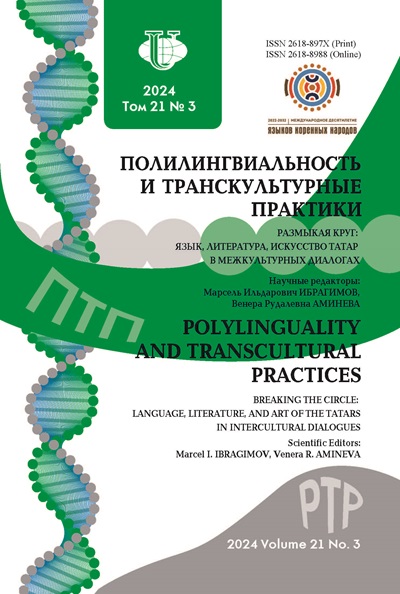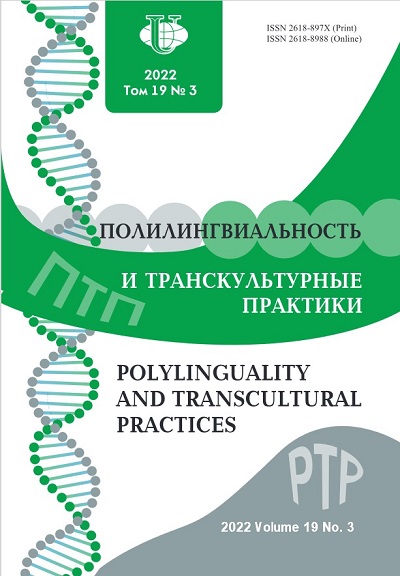Interlinguistic Interaction in the study of Russian as a Foreign Language in the Conditions of the Belarusian-Russian Linguistic and Cultural Environment
- Authors: Grinberg S.A.1
-
Affiliations:
- Vitebsk State Academy of Veterinary Medicine
- Issue: Vol 19, No 3 (2022)
- Pages: 453-461
- Section: Language Processes
- URL: https://journals.rudn.ru/polylinguality/article/view/32072
- DOI: https://doi.org/10.22363/2618-897X-2022-19-3-453-461
Cite item
Full Text
Abstract
This study is devoted to an urgent problem of teaching Russian as a foreign language in the Republic of Belarus - the problem of interlinguistic interaction in the conditions of Belarusian-Russian bilingualism. Closely related bilingualism gives a rich picture of the world, promotes the development of multicultural consciousness and increases the potential capabilities of the individual, since two national cultures - Russian and Belarusian are broadcasted at once through one language (Russian). Mastering the norms of intercultural communication is carried out in various fields: educational, social, cultural, scientific, professional. A teacher of Russian as a foreign language has a special task - to ensure a harmonious combination of the culture of the language being studied (Russian), the culture of the residence country (Belarus) and the national culture of the student studying. The result of interlinguistic interaction is the formation in his mind the so-called “mixed” interlingual zone, including the elements of different language systems, which are not identified by the speaker as belonging to separate languages, hence can enter different linguistic contexts. In the course of the analysis, we came to the conclusion that the main functions of communication are currently assigned to the Russian language, while the Belarusian language acts as a translator of the national ideology and cultural symbolism.
About the authors
Svetlana A. Grinberg
Vitebsk State Academy of Veterinary Medicine
Author for correspondence.
Email: s_grinberg@mail.ru
ORCID iD: 0000-0001-7584-9402
PhD in Philological Sciences, head of the Department of Foreign Languages, Associate Professor
7/11, Dovatora st., Vitebsk, 210026, Republic of BelarusReferences
- Bakhtin, M.M. 1986. Estetika slovesnogo tvorchestva. Moscow: Iskusstvo publ. Print. (In Russ.)
- Shchukin, A.N. 2002. Metodika prepodavaniya russkogo yazyka kak inostrannogo. Moscow: Vysshaya shkola publ. Print. (In Russ.)
- Mechkovskaya, N.B. 1994. “Yazykovaya situatsiya v Belarusi. Eticheskiye kollizii dvuyazychiya”. Russian Linguistics 18(3): 299—322.
- Bakhtikireeva, U.М. 2014. “Teoriya bilingvizma v russkom yazykoznanii”. In Lingvistika XXI veka: Collection of Articles. Moscow: Flintа publ. Print. (In Russ.)
- Garbovsky, N.K. 2004. Teoriya perevoda. Moscow University publ. Print. (In Russ.)
- Akulenko, V.V. 1969. Anglo-russkiy i russko-angliyskiy slovar’ «lozhnykh druzey perevodchika». Moscow: Sovetskaya Encyclopedia publ. Print. (In Russ.)
- Kratkiy etimologicheskiy slovar’ russkogo yazyka. 1971. Edited by Shansky N.M., Ivanov V.V., Shanskaya T.V. Moscow: Prosveshcheniye publ. Print. (In Russ.)
- Bielaruskaja mifalohija. 2006. Minsk: Belarus publ. Print. (In Russ.)
- Vereshchagin, E.M., Kostomarov, V.N. 1983. Yаzyk i kul’tura: lingvostranovedeniye v prepodavanii russkogo yazyka kak inostrannogo. Moscow: Russkiy yazyk publ. Print. (In Russ.)
- Mechkovskaya, N.B. 1973. Sotsial’naya lingvistika. Moscow: Aspect Press publ. Print. (In Russ.)
- chweitzer, A.D. 1973. Perevod i lingvistika. Moscow: Voyenizdat publ. Print. (In Russ.)
- Komissarov, V.N. 1990. Teoriya perevoda. Moscow: Vysshaya shkola publ. Print. (In Russ.)
- Shkraba, I.R. 2008. Slownik belaruskaj biezekvivalientnaj leksiki. Minsk: Belarus. Еncyklapiedyja imja P. Browki publ. Print. (In Russ.)
- Etymalahichny slownik belaruskaj movy. 1985. Minsk : Navuka i tekhnika publ. Print.
- Mechkovskaya, N.B. 2004. Belorussko-russkoye dvuyazychiye i suverenitet Belarusi. In Materials of the international scientific conference “Kul’tura rechi v usloviyakh bilingvizma: sostoyaniye, perspektivy, innovatsionnyye tekhnologii”. Minsk. Print. (In Russ.)















